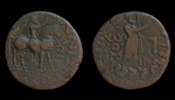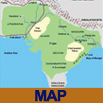|
|
Azes II was succeeded by Gondophares, a Parthian, related with Avars, people from Central Asia. King Vindafarna (Gondophares) separated from the Arsacid Parthians and conquered the Indus Valley, Gandhara and Sakasthan. They are called Pahlavas in Indian accounts.
Gondophares called himself �King of Kings�. The obverse of his coins bears a King on horseback. Nike, Pallas, and Zeus the Greek deities appear on the reverse. He also issued coins in which Siva is facing and holding in right hand trident and in left hand palm.
Gondophares is depicted in left profile with a simple diadem having a frontal ornament (obverse) and being crowned by Nike (reverse). He was probably followed by Sases, whose issues are quite rare (only 5 specimen known so far). Portrait and legend is very much similar to Gondophares, but on the obverse he wears a tiara and on the reverse he is called Gondophares, but Greek legend ends with SAH, reading SASH/Sase also Greek deity Zeus forming a benediction sign. Sases, also known as Gondophares IV Sases, he apparently succeeded Abdagases in Sindh & Gandhara, & sometimes during his 26 years reign assumed title of Gondophares, which was held by Supreme Indo-Parthian rulers.
Indo-Parthian coins were inspired by Arsacid dynasty, after the death of Gondophares I, the empire started to disintegrate. The title Gondophares was adapted by Sarpedones, Gondophares II, he issued fragmented coinage in Sind, Eastern Punjab & Arachosia (Southern Afghanistan). The most important successor was Abdagases, Gondophares nephew, ruled in Punjab & Seistan. Sarpedones succeeded by Orthaganes (Gondophares III Gadana), ruled in Seistan & Arachosia with Abdagases during first AD. After 20 AD, Sases nephew of Aspavarma took over Abdagases & became Gondophares IV Sases.
There were other minor Kings; Sanabares in Seistan, Agata in Sind, But Indo Parthian never regained the position of Gondophares I, from 1st Century AD the Kushan ruler Kajula Kadphises began absorbing the northern Indian part of the Kingdom. The last ruler Pacores only ruled Seistan & Kandahar.
On their coins there are no explicit records of religion, they are depicted with short cross over jackets & large baggy trousers, possibly supplemented by Chap-like over-trousers. Their jackets are adorned with decorative rings or medals, hair is usually bushy and contained with a handband.
Sase was followed by Orthagnes depicted with a simple tiara and by Ubouzanes, in Greek legend he specifies as Orthaganes� son.
Traces of Indo-Parthian Kings in Gandhara and Taxila area are numerous than elsewhere. In this region they initiated Indo-Scythian coins, with a king mounted on horseback on the obverse and a Greek deity (Zeus, Athena) on reverse. In these two mints three Kings struck coins: Gondophares, Abdagases, and Sases.
Few coins struck in Sindh (the lower Indus Valley) are known. Silver, drachms, bearing the bust of the King wearing a tiara, with a Greek legend (obverse) and a Nike holding a crown and a kharoasthi legend (reverse). Three Indo-Parthian Kings struck coins in Sindh, Sarpedones (goatee beard), Satavastres and Sases. These coins were subsequently imitated by Kushan Kajula Kadphises. |
|
|


